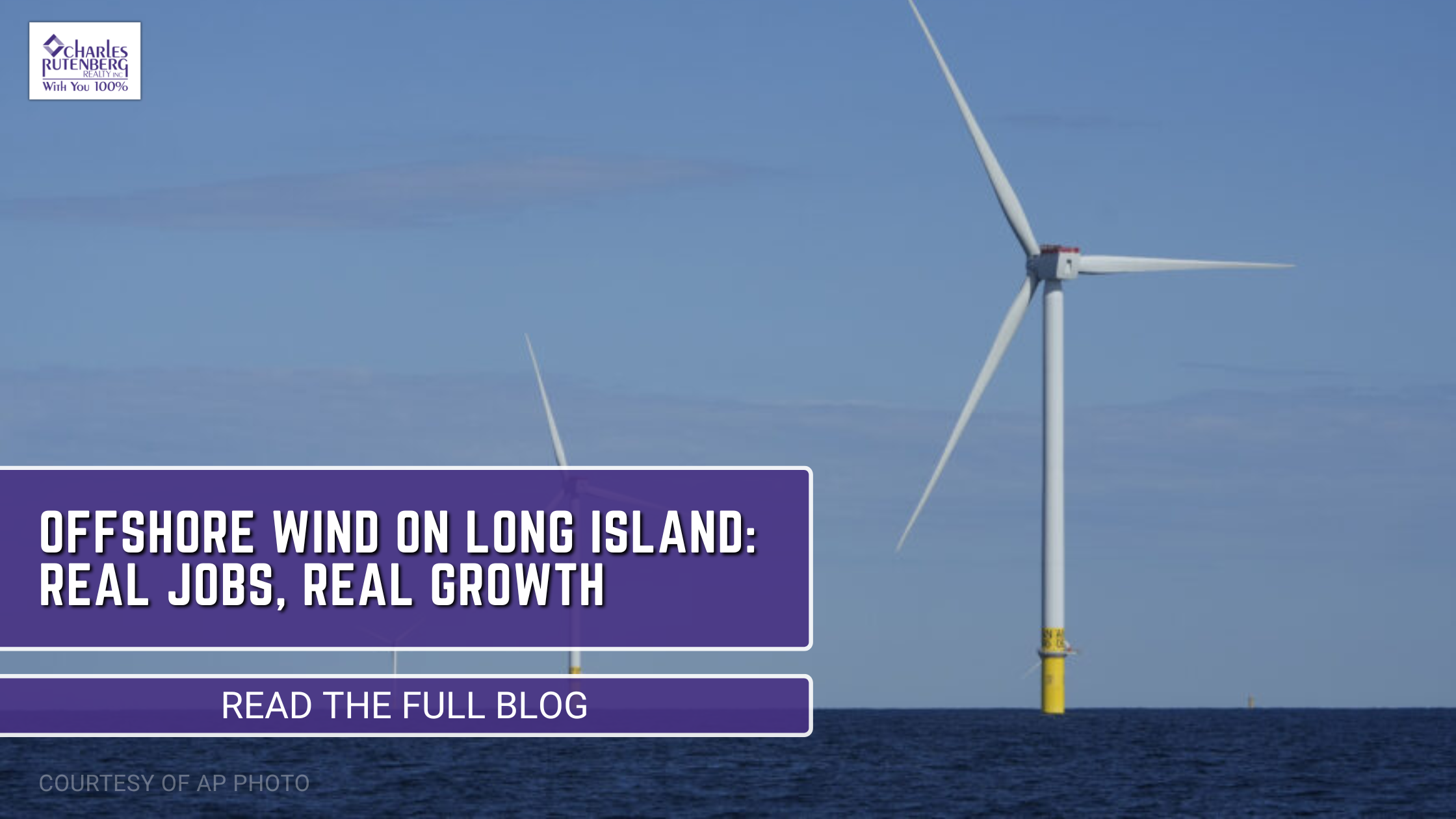Offshore Wind on Long Island: Real Jobs, Real Growth (and Why It Matters for Real Estate)

In Brief
-
Empire Wind: ~$5B investment with capacity to power ~500,000 homes.
-
South Fork Wind: already delivering power to ~70,000 Long Island homes.
-
Ørsted & Equinor projects have created thousands of local jobs to date.
-
Offshore wind boosts U.S. energy security and domestic supply chains.
-
Long Island manufacturers and workforce training programs benefit directly.
The short version
Walk the waterfront at Brooklyn’s Sunset Park and you’ll spot a new American-flagged barge at the South Brooklyn Marine Terminal (SBMT). It’s laying American-made subsea cable that will connect the Empire Wind project straight into New York City’s grid. It’s not a rendering. It’s happening now—and it’s great news for Long Island’s economy, housing market, and long-term affordability.
Why real estate pros should care
Offshore wind isn’t just an energy story—it’s a jobs and stability story. In a market where buyers watch monthly costs and sellers worry about demand, steady job growth and infrastructure investment are rocket fuel. More high-quality jobs = stronger household incomes = more confident buyers and renters. Here’s what’s on the board right now:
-
South Fork Wind (Ørsted): Operational and powering ~70,000 homes.
-
Sunrise Wind (Ørsted): Next in line, with Ørsted reporting 1,400+ workers and 3M+ labor hours supported so far and ~$58M in local economic impact.
-
Empire Wind (Equinor): ~$5B capital investment with the capacity to power ~500,000 homes; SBMT will serve as control center and long-term maintenance base. The project has already supported 2,000+ jobs, mobilizing U.S. suppliers from steel shops to underground utility crews.
Zoom out and the pipeline is bigger: Vineyard Wind in Massachusetts has employed 1,700 local workers, and Dominion’s Coastal Virginia project is slated to power ~660,000 homes. New York’s next tranche of contracts could include players like Community Offshore Wind, with others poised to re-enter as conditions improve.
The Long Island angle: what changes on our streets
1) More resilient local demand
When aerospace left Long Island decades ago, we learned the hard way what happens when one industry fades. Offshore wind is our chance to diversify again—bringing advanced manufacturing, marine construction, and data-driven O&M (operations and maintenance) careers. That stability supports consistent housing demand from entry-level rentals to move-up buyers.
2) A lift for small manufacturers
With 2,000+ manufacturers across Nassau and Suffolk, the region is positioned to win subcontracts—from precision metalwork to cable trays and components. Owners reinvest in facilities, hire locally, and often expand nearby—good for industrial land values and nearby residential demand.
3) Training that keeps talent here
Workforce programs aligned to wind tech, high-voltage electrical, composites, and maritime trades keep our young adults on the Island. Graduates who land good, future-ready jobs are far more likely to form households here—supporting rental absorption and first-time buyer segments.
4) Energy security = predictable bills
A more balanced energy mix can reduce volatility. Predictable utility costs help buyers qualify and make it easier for landlords and HOAs to budget, which indirectly supports property values and cap rates.
What this means for buyers, sellers, and investors
For Buyers: Follow the jobs. Neighborhoods with easy access to train lines, ferries, and major employment nodes (Huntington, Patchogue, Long Beach, Mineola, Ronkonkoma) can see earlier demand bumps. Look for energy-efficient homes—lower monthly carrying costs are a winning tie-breaker.
For Sellers: Highlight efficiency upgrades (insulation, heat pumps, solar readiness), commute options, and proximity to training centers or industrial corridors. Today’s buyers shop with spreadsheets—monthly savings and convenience matter.
For Investors/Developers: Watch SBMT-linked logistics corridors and Long Island’s industrial pockets near highways and rail. Mixed-use near town centers with transit access is positioned to capture the worker base. Consider adaptive-reuse plays for light industrial or flex—wind supply chains love ceilings, power, and loading docks.
FAQ
Is Empire Wind really a $5B project?
Yes. It’s a multi-billion-dollar investment with capacity to power roughly 500,000 homes, anchored by the South Brooklyn Marine Terminal for control and maintenance.
How many Long Island homes are already powered by offshore wind?
South Fork Wind is providing power equivalent to roughly 70,000 homes.
How many jobs are tied to Ørsted’s projects so far?
More than 1,400 workers have logged over 3 million hours connected to South Fork and Sunrise Wind, with an estimated ~$58M local economic impact.
What about Equinor’s Empire Wind jobs?
To date, the project has supported 2,000+ jobs and activated a wide network of American suppliers.
Will offshore wind lower my electric bill?
Bills depend on many factors, but a more diverse, domestic energy mix can improve resilience and reduce exposure to price shocks.
Which Long Island areas could see the biggest real estate benefit first?
Transit-served town centers, waterfront communities connected to marine logistics, and industrial-adjacent neighborhoods with active manufacturing bases often feel the impact early.
How can local businesses get involved?
Monitor procurement portals for Ørsted, Equinor, and New York State, connect with regional manufacturing alliances, and explore workforce programs focused on electrical, maritime, and composites.
Is this compatible with tourism and coastal life?
Yes. Construction is staged and offshore; operations have minimal onshore footprint. Ports and terminals are being modernized to support both maritime industry and public realm improvements.
Tags: Ørsted South Fork Wind, Empire Wind, Equinor, South Brooklyn Marine Terminal, Sunrise Wind, clean energy jobs, renewable energy, Long Island economy, workforce development, New York offshore wind, Long Island real estate
